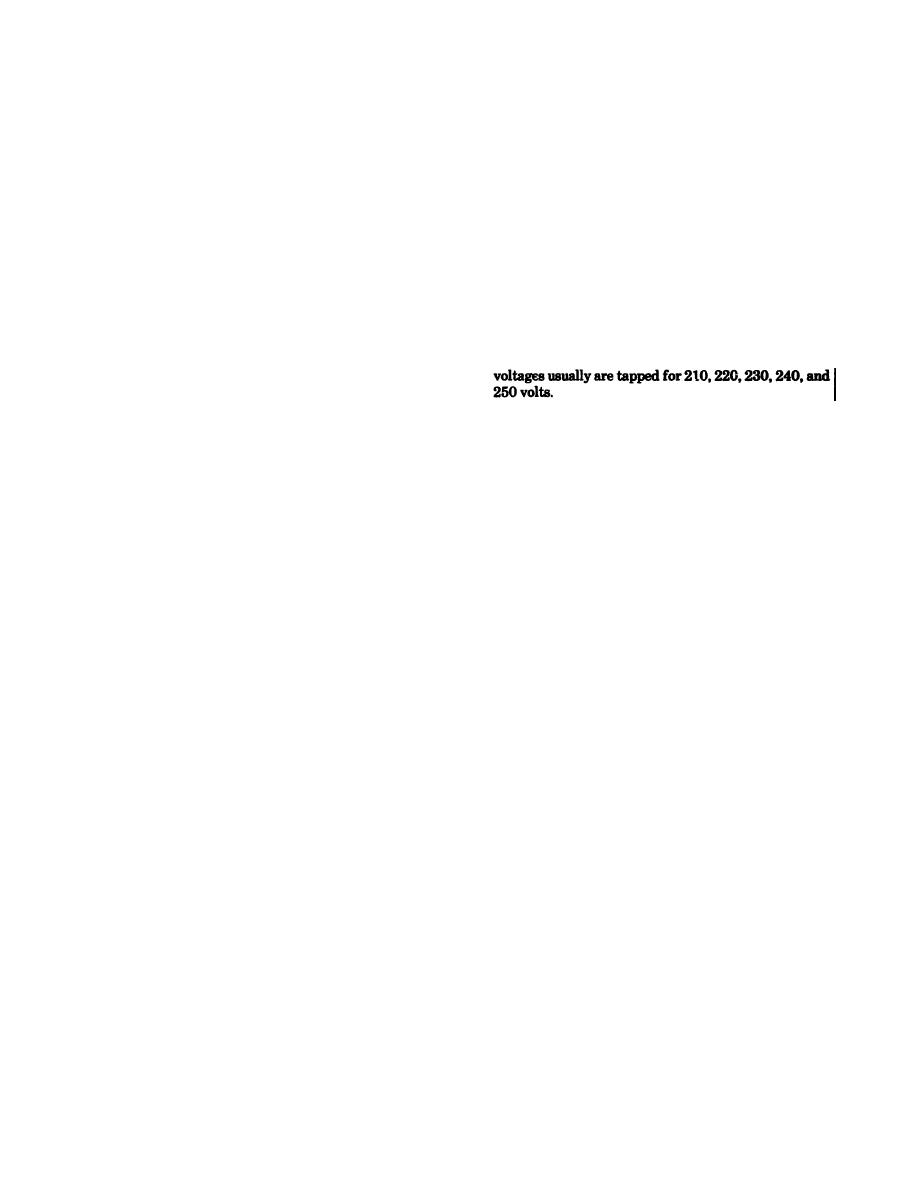 |
|||
|
|
|||
|
|
|||
| ||||||||||
|
|
 TM 11-5895-1012-10
However, equipment that requires large amounts of
c. Auxiliary Power. Auxiliary power is provided at
power, such as a high-powered radio transmitter,
each DCS Station to replace all or part of the primary
generally is designed to operate on 240 or 480 volt,
power in case of failure. This auxiliary power is usually
three phase power. These are nominal voltages, and a
supplied by engine-generators and storage batteries.
variation of 5 percent usually can be tolerated.
These engine-generators are installed and operated as
(1) Some equipment is built with power input
part of the DCS Station. Auxiliary power is the
transformers, that have tapsbrought out to terminals.
currently-approved designation for back-up or altern-
These taps are on the primary (input) side of the trans-
ate power sources frequently referred to as emergency
former, and are marked with a common voltage value.
power sources.
For example, a transformer in a piece of equipment
d. Emergency Lighting Power. Emergency power
may have-either three or five taps. If there are three
requirements at DCS Stations are normally limited to
tap, they usually are marked 105, 115, and 125 volts;
battery-powered lighting systems for use while
if there are five taps, they are usually marked 105,
auxiliary power equipment is being activated after
110, 115, 120, and 125 volts. Transformers for higher
failure of the primary power supply. These emergency
systems are normally automatically activated im-
mediately upon failure of the primary or auxiliary
(2) Three-phase power requirements at DCS
power supply, and are removed from service as soon as
Stations are usually at a nominal 120/208 volt po-
primary or auxiliary ac power is restored.
tential. However, some RF power amplifiers etc., may
2-24. Classes of Power
be designed to operate on different voltages, such as
240 or 416 volts. These voltages are supplied by
Station power is divided into four classes as follows:
special transformer configurations.
a. Class A Primary Power. A primary power plant
c. Phase. Equipment that requires 120-volt input
which provides an essentially continuous supply of
power is generally designed for single-phase power
electrical power.
most equipment that requires 240-volt input power is
b. Class B Auxiliary Power. A standby power plant
designed for three-phase power. The generation of
to cover extended outages (usually days in length) of a
three-phase power is accomplished by three separate
primary power plant.
induction coils in the generator. The method of
c. Class C Auxiliary Power. A quick start (10 to 60
connecting these three coils results in various
seconds) unit(s) to cover short-term outages (usually
configurations, and may be arranged to give different
hours in length) of a primary power plant.
voltages in the range of 208 to 480 volts. The three-
d. Class D Auxiliary Power. An uninterruptible (no
coils, and the individual phases they produce, are
break) power unit(s) using stored energy to provide
separated by 120 degrees so that there is equality be-
continuous power within specified voltage and fre-
tween the three phases. Higher powered generating
quency tolerances.
plants normally produce three-phase power. The
majority of the DCS Station equipment uses only
single-phase power. Distribution of primary power
AC power is available in many different forms (voltage,
within the station is important; therefore, disparity
phase, and frequency). The type required by a particu-
between loads on individual phases creates problems
lar DCS Station is determined by the equipment in-
and should be balanced within reasonable limitations.
stalled at that DCS Station.
2-26. Generating Equipment
equipment manufactured in the United States is avail-
a. General. The engine-generator sets provided at
able in models that require an input frequency of 60-
the DCS Stations are used for primary or auxiliary
Hertz (Hz). Some equipment is also available in models
that can operate on ac power supplied at different fre-
power requirements. For use as either a primary power
source or an auxiliary power source, the electrical
quencies, such as 25 or 50 Hz. Most foreign-made
characteristics are the same. Normally, the only dif-
equipment is designed to operate only from 50 Hz
ference is that more sets of equipment are required if
power sources. Since most of the equipment at any
DCS Station will be manufactured in the United
they are used to produce power at all times. For
example, the general practice for auxiliary power is to
States, the primary ac power source should be 60 Hz.
So that equipment designed for other frequencies can
provide two complete sets of power generating equip-
be operated, a rotary or solid-state static type con-
ment. When they are used to provide all power for the
verter is used to change the frequency of the primary
station, at least three complete sets of equipment are
power.
required.
b. Voltage. Most communications and test equip
b. Engines. The engine, or prime-mover is designed
nave more horsepower than the generator rating;
ment is designed to operate on 120 volts single phase.
|
|
Privacy Statement - Press Release - Copyright Information. - Contact Us |